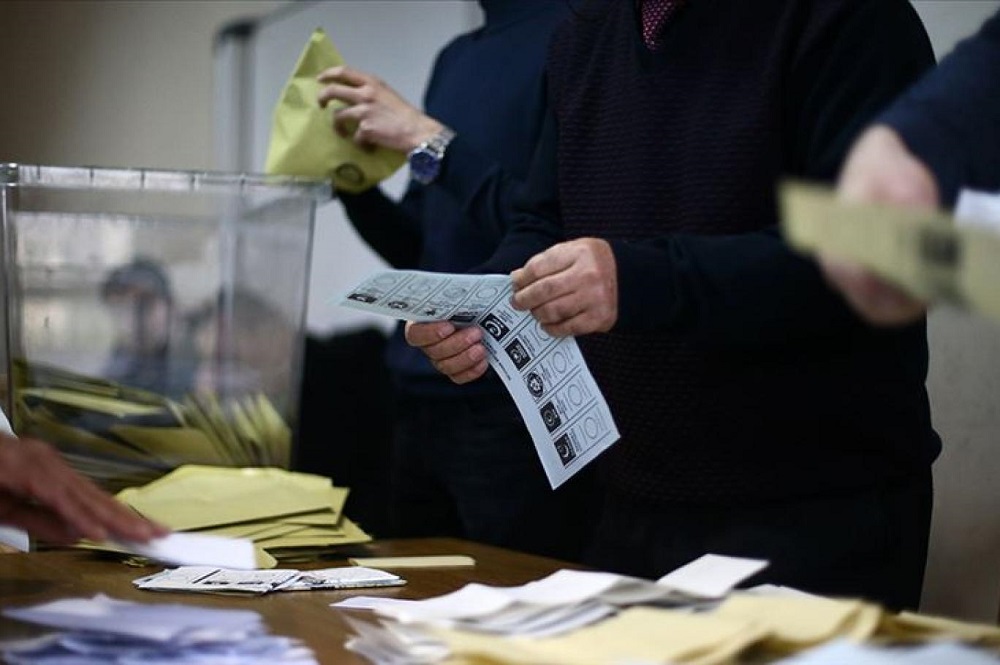CoE election observers urge Turkey to do more to protect freedom of expression
It’s possible that I shall make an ass of myself. But in that case one can always get out of it with a little dialectic. I have, of course, so worded my proposition as to be right either way (K.Marx, Letter to F.Engels on the Indian Mutiny)
Tuesday, April 02, 2024
Post-USSR, the left has struggled to provide an alternative, while conservatism has evolved into the ‘radical right’ — leaving little hope for the future

In 2003, the literary critic Fredric Jameson famously observed that ‘it is easier to imagine the end of the world than the end of capitalism.’ For the first time in two centuries, he noted, capitalism was viewed as both destructive and irreversible. Waning faith in the possibility of a post-capitalist future has nurtured deep pessimism.
This prevailing despair evokes John Maynard Keynes’s 1930 essay Economic Possibilities for Our Grandchildren, in which he warned against the ‘two opposed errors of pessimism’. The first was the pessimism ‘of the revolutionaries who think that things are so bad that nothing can save us but violent change’. The second was the pessimism of reactionaries who view economic and social structures as ‘so precarious that we must risk no experiments’.
Two different visions of a post-capitalist world
In response to the pessimisms of his time, Keynes offered an alternative vision, predicting that technology would usher in an era of unprecedented abundance. Within a century, he argued, continuous technological progress would elevate living standards – at least in the ‘civilised’ world – to 4-8 times what they were in the 1920s. This would enable his generation’s grandchildren to work a fraction of the hours their ancestors did.
The short-term employment theory for which Keynes is widely known was part of this larger vision of technological utopia. In his view, running the economy at full capacity was the quickest route from necessity to freedom. Once we achieve this goal, the economic ‘dentistry’ that preoccupied Keynes would become redundant. Our attention could then shift to ‘our real problems’, those of ‘life and of human relations, creation, behaviour and religion’.
Despite their utopian visions of a post-capitalist world, Keynes and Marx had fundamentally different views on how to overcome the capitalist ‘monster’.
Although Keynes found Karl Marx’s ideas incomprehensible, his vision of a post-capitalist future resembled that of Marx in The German Ideology. Marx regarded capitalism as a means to address the problem of production, while communism was viewed as a way to manage distribution, thereby eliminating the need for a division of labour.
Much like Keynes, Marx’s vision of the future championed the cultivated amateur, a role traditionally reserved for the aristocracy. Marx envisioned a society where one could ‘hunt in the morning, fish in the afternoon, rear cattle in the evening’ and ‘criticise after dinner’ without being confined to the role of hunter, fisherman, shepherd or critic. Like Keynes, he saw capitalism as an ordeal humanity had to endure so that the good life could be democratised.
Although Keynes and Marx viewed capitalism as a necessary evil, both opposed hasty efforts to abolish it or meddle too forcefully in its workings. Keynes warned against prematurely dismantling the capitalist system through wealth and income redistribution, while Marx believed that reformist attempts to humanise capitalism would merely delay the revolution. These rigid stances ultimately proved too extreme for the Keynesians and socialists who sought to establish Keynesian social democracies in the mid-twentieth century.
It is the absence of a redemptive vision that sustains, and partly defines, today’s prevailing pessimism.
But despite their utopian visions of a post-capitalist world, Keynes and Marx had fundamentally different views on how to overcome the capitalist ‘monster’, stemming from their distinct interpretations of the system. For Keynes, capitalism was a spiritual deformation that had spread through Western civilisation on the vector of Puritanism and would naturally perish once it was no longer needed. In an era of abundance, ‘the love of money as a possession – as distinguished from the love of money as a means to the enjoyments and realities of life – will be recognised for what it is’, a ‘somewhat disgusting morbidity’ that one ‘hands over with a shudder to the specialists in mental disease.’
By contrast, Marx did not view capitalism as a psychological affliction; instead, he saw it as a political and social system wherein the capitalist class monopolised ownership and control of land and capital. This dominance enabled capitalists to extract surplus value from workers, whose only saleable commodity was their labour power. Capitalism, Marx argued, would not simply wither away; it had to be overthrown, but not before its creative potential had been fully realised.
Marx’s portrayal of capitalism as a creative force was rooted in Hegel’s dialectic and significantly influenced by Mary Shelley’s 1818 novel Frankenstein; or, The Modern Prometheus. Another source of inspiration was Goethe’s Faust, where Mephistopheles is depicted as a diligent executor of God’s plan for human redemption.
Where do we go from here?
In many respects, today’s pessimism is more profound than the one Keynes identified in 1930. Leftist revolutionaries still long for capitalism’s downfall, yet they have failed to provide a viable political alternative since the collapse of Soviet communism. Meanwhile, conservatism has evolved into the ‘radical right’, characterised by resentment and chauvinism but lacking a coherent vision for a harmonious future. Neither side seems to offer a light at the end of the tunnel.
It is the absence of a redemptive vision that sustains, and partly defines, today’s prevailing pessimism. While Keynes and Marx believed in the emancipatory power of machines, technology is now widely viewed as a menace, even as our future remains deeply intertwined with it. Similarly, Keynes and Marx assumed that capitalism would collapse long before nature rebelled against its exploitation; we now face the existential threat of climate change, with little hope of a successful global effort to combat it. Most alarmingly, public trust in the ability of democratic systems to deliver meaningful progress is rapidly eroding.
Faced with a choice between parasitic capitalism and emerging neo-fascism, pessimism is reasonable. But given that neither the end of the world nor the end of capitalism seems imminent, the question remains: Where do we go from here?

Robert Skidelsky is a member of the British House of Lords and Professor Emeritus of Political Economy at Warwick University.
 |
| 1933 |
 |
| 2023 |
Google has agreed to destroy “billions of data records” collected during private browsing sessions to settle a class-action lawsuit that accused the tech giant of improperly tracking people who thought they were browsing the internet privately.
The company also agreed to rewrite the disclosure that appears at the beginning of every “incognito mode” session to inform users that it collects data from private browsing sessions, according to court documents filed Monday.
Google must also allow incognito mode users to block third-party cookies for the next five years as part of the settlement.
“This settlement is an historic step in requiring dominant technology companies to be honest in their representations to users about how the companies collect and employ user data, and to delete and remediate data collected,” the filing, submitted by the plaintiffs’ attorneys, reads.
Google spokesperson José Castañeda also touted the settlement, emphasizing that it does not require the company to make any payments. However, individuals still retain the right to sue for damages under the settlement.
“We are pleased to settle this lawsuit, which we always believed was meritless,” Castañeda said in a statement. “The plaintiffs originally wanted $5 billion and are receiving zero.”
“We never associate data with users when they use Incognito mode,” he continued. “We are happy to delete old technical data that was never associated with an individual and was never used for any form of personalization.”
Here’s where abortion measures are on the ballot in November

Protesters against abortion demonstrate outside the Supreme Court in Washington, D.C., during the argument of FDA v. Alliance Hippocratic Medicine on Tuesday, March 26, 2024.
Advocates are pushing to put abortion on the ballot — literally — in November, spurring hope among Democrats that having measures aimed at enshrining rights around the procedure could boost turnout and help their candidates in the most competitive races.
Seven states have voted on abortion since the Supreme Court overturned Roe v. Wade back in 2022, handing the issue over to individual states back in 2022. Voters in Michigan, California and Vermont approved measures enshrining abortion rights in their state constitutions during the midterms, while Montana and Kentucky rejected restrictions to the procedure. Deep-red Ohio also voted last year for an abortion protections amendment.
Now, measures aimed at solidifying reproductive rights are already on the 2024 ballot in several states, while similar efforts are underway in other parts of the country.
Here’s where the abortion ballot measure movement stands in various states ahead of November:
On the ballot
Florida
The Florida state Supreme Court decided on Monday to allow a ballot measure that would enshrine abortion protections to go before voters in the fall.
Supporters in the Sunshine State gathered enough signatures to qualify for the ballot, but the state court needed to approve the measure’s language.
The amendment could undo Florida’s conservative restrictions on abortion. The procedure is currently banned at 15 weeks, and Florida Gov. Ron DeSantis (R), who ran an unsuccessful bid for the White House this year, signed a six-week abortion ban last spring that’s yet to be enacted.
The Florida Supreme Court on Monday also affirmed the 15-week ban, opening the door for the DeSantis-backed restrictions to go into effect. But Floridians will now also get a chance to nullify those bans when they vote on the measure in November.
“We’re counting down the days until the court might rule on a six-week ban,” Laura Goodhue, executive director of the Florida Alliance of Planned Parenthood Affiliates, told The Hill just before the decision. “And we already see people being harmed by the ban that’s in place. There’s just too many hurdles for people to access care.”
Maryland
The Old Line State is a blue stronghold where abortion is legal until viability, but advocates want to take action against any future threats.
Voters in Maryland are set to weigh an amendment to the state constitution that would establish a “fundamental right to reproductive freedom” and restrict the state from burdening or abridging that right.
Gov. Wes Moore (D-Md.) has said the state will be “a safe haven for abortion access” as long as he holds the governor’s mansion, but the proposed amendment “will make sure it remains that way, no matter who is in office.”
The measure could also help turnout in the state, as Democrats ready for a potentially competitive Senate race after popular Republican former Gov. Larry Hogan jumped into the ring.
New York
New Yorkers are set to vote this fall on whether to ratify an Equal Rights Amendment that would, along with bolstering other rights, protect against government actions that would curtail access to reproductive care.
Abortion is legal until viability and largely safe from threat in the blue state, but advocates want to enshrine the protections while they can to safeguard against future threats.
“These legal protections go above and beyond the protections of the federal constitution, and insulate New Yorkers from state political winds that seek to eliminate or narrow existing legal protections,” said New Yorkers for Equal Rights, the coalition arguing for the amendment passage.
The move to include the amendment on the 2024 ballot may also serve as a boost for Democrats in a state that is set to be key to deciding control of the lower chamber. With multiple competitive House races in play, strategists say an abortion-related measure could energize the party and help tilt the scales in its favor.
In progress
Arizona
In Arizona, advocates are collecting signatures to get another constitutional amendment that would protect abortion before viability in front of voters this fall.
Abortion is restricted after 15 weeks in the Grand Canyon State, with exceptions for medical emergencies. The state Supreme Court has also been asked to reinstate a near-total ban, and courts are litigating a law that criminalizes a doctor for performing an abortion sought solely because of a genetic abnormality, according to the state attorney general.
“We have a state legislature where a majority of [those] that serve are really anti-abortion, quite frankly,” Chris Love, a senior adviser for Arizona for Abortion Access, told The Hill. “They are ready to ban abortion and pass more extreme bans as time goes on. And so I think the time is now to address this issue. This is our shot to ensure that we’re protecting abortion rights.”
Arizona is holding a competitive Senate race this year after Democrat-turned-Independent Sen. Kyrsten Sinema opted against running for reelection and teed up a likely showdown between Democratic Rep. Ruben Gallego and Republican former gubernatorial candidate Kari Lake. The swing state is also likely to be instrumental in the White House race.
Colorado
Organizers in Colorado are collecting signatures to get an amendment on the ballot that would formally recognize “the right to abortion” and prevent the government from denying or impeding it, including by prohibiting health insurance coverage for the procedure.
In the Centennial State, which has no gestational limits for abortion care, a Republican state lawmaker earlier this month put forward a bill that would have assigned “personhood” to fetuses at conception, as reported by Colorado News Online.
Coloradans for Protecting Reproductive Freedom pointed to the bill as “exactly why” they’re fronting the effort to enshrine abortion protections even in a state that currently offers legal access.
Missouri
An amendment being circulated by Missourians for Constitutional Freedom would set up the individual right “to make and carry out decisions about all matters relating to reproductive health care.”
Missouri was the first state to enact a “trigger law” after Roe was overturned, and has one of the most restrictive policies in the country. Abortion is completely banned in the red state, and requires an “affirmative defense” to meet the criteria for an exception, according to the Guttmacher Institute.
Advocates have been hosting petition-signing events to meet the state’s in-person requirements as they work to hit the threshold they need to get on the ballot.
Montana
The Republican state attorney general in Montana labeled a ballot measure to protect abortion invalid, but the state’s Supreme Court earlier this month overruled the move, moving the effort forward.
Abortion is legal before viability in Montana, but advocates want to take quick action to shore up those protections in a state controlled by a Republican governor and GOP-led state legislature.
“While abortion is currently legal in Montana, our rights are not guaranteed.” advocates told The Hill in a joint statement from Akilah Deernose, the executive director of the ACLU of Montana; Kiersten Iwai, the executive director of Forward Montana; and Martha Fuller, CEO and president of Planned Parenthood Advocates of Montana.
“Over a dozen anti-abortion bills were introduced during the 2023 Montana legislative session alone, and many were signed into law. We can no longer exclusively play defense against attacks, and we must secure the rights Montanans deserve.”
Strategists stressed that the measure could — as in other states — serve as a boost to Democrats, as incumbent Sen. Jon Tester (D) fights to keep his seat in one of the most closely watched Senate races this year.
Nebraska
A Right to Abortion amendment in Nebraska would add protections for abortion until viability, and the Protect Our Rights effort has until July to collect the signatures they need to get on the ballot.
At the same time, another petition in circulation would ban abortion in the second and third trimesters.
Nebraska’s governor signed a 12-week abortion ban last year, which the state’s Republican governor has called “the most significant win for social conservative agenda in over a generation of Nebraska.”
Nevada
A Reproductive Rights Amendment in Nevada would protect a right to abortion up to the point of fetal viability, or when the procedure is needed to protect the life or health of the pregnant patient.
The amendment would protect the procedure “unless justified by a compelling state interest that is achieved by the least restrictive means,” which the text then defines as limited to an interest in “protecting, maintaining, or improving the health of an individual who is seeking abortion care that is consistent with accepted clinical standards of practice.”
Abortion is legal in Nevada for the first 25 weeks.
The US National Transportation Safety Board is still ‘analysing the ship’s manifest to determine what was onboard’ in its other 4,644 containers
PTI Colombo Published 02.04.24

The Singapore-flagged container ship vessel Dali, which was mainly manned by an Indian crew, collided with the 2.6-km-long four-lane Francis Scott Key Bridge over the Patapsco River in Baltimore in the early hours of March 26.
Sri Lanka is not yet aware of the nature of hazardous materials on the cargo vessel that collided with a key Baltimore bridge last week as it was supposed to declare the contents of containers only 72 hours before the time of arrival into the Colombo Port, officials here said.
The Singapore-flagged container ship vessel Dali, which was mainly manned by an Indian crew, collided with the 2.6-km-long four-lane Francis Scott Key Bridge over the Patapsco River in Baltimore in the early hours of March 26. The 984-foot cargo ship was bound for Colombo, Sri Lanka.
The ship was carrying 764 tonnes of hazardous materials as reported by the US media.
According to the information available, there are 57 containers with such toxic materials that can be categorised under the International Maritime Dangerous Goods Code. The waste included mostly corrosives, flammables, miscellaneous hazardous materials, and Class-9 hazardous materials, including explosives & lithium-ion batteries – in 56 containers. So says the US National Transportation Safety Board, still ‘analysing the ship’s manifest to determine what was onboard’ in its other 4,644 containers, Daily Mirror Online quoted the official as saying.
"Prior to Baltimore, Dali called at New York and Norfolk, Virginia, which has the world’s largest naval base. Colombo was to be its next scheduled call, going around South Africa’s Cape of Good Hope, taking 27 days, scheduled to land just after our New Year," the official said.
Sri Lanka Ports Authority (SLPA) Chairman Keith Bernard said the ship should declare the contents of containers only 72 hours before the time of arrival at the Colombo Port.
“The ship is supposed to arrive here on April 21, 2024. It means they are supposed to inform us by April 17 or so. There is enough time. If there are containers with hazardous items as declared by them, we will isolate such containers in accordance with protocols. As a major transhipment hub, we have a procedure set in place to deal with such containers. Most likely, these containers are meant for transhipment,” he said.
Asked about the procedure if the containers are meant to be allowed into the country, he said the clearance of the Defence Ministry and others would be sought.
However, Deputy Director of the Central Environment Authority (CEA) Ajith Wijesundara said it is not yet clear whether the ship was carrying containers with hazardous wastes or toxic substances. According to the Basel Convention, he said such wastes would not be allowed into the country.
He added that toxic substances are imported as raw materials and guidelines are applied.
The collapse of the bridge has effectively shut down operations at Baltimore’s port, affecting about 8,000 jobs and about USD 2 million in daily wages for those workers, US Transportation Secretary Pete Buttigieg said last week.
Singapore-flagged ship Dali stuck under bridge with mostly Indian crew since last Tuesday
The crew members stranded for a week on board a cargo vessel that collided with the Francis Scott Key Bridge in Baltimore were worried what the world thought of them, an official said.
The Singapore-flagged ship Dali, en route to the south Asian country, has been stuck with 4,000 containers and its mostly Indian crew since last Tuesday after the vessel lost power and collided with a support column of the bridge, leading to its collapse.
The 20 Indian and one Sri Lankan sailors were in good health, including a member who suffered minor injuries, according to officials
The “rattled” sailors had adequate food on board but were keeping quiet about their situation amid an ongoing investigation, said Joshua Messick, the executive director of the non-profit Baltimore International Seafarers’ Center.
“They’re not saying much at all to anyone who has been in touch with them,” Mr Messick told the BBC.
“They didn’t have WiFi until Saturday and they didn’t really know what the perception of the rest of the world was. They weren’t sure if they were being blamed, or demonised. They just didn’t know what to expect.
“They are also in a very sensitive situation. What they can say can reflect on the company. I would imagine that they’ve been advised to keep a low-profile for the time being,” he added.
There has been very little information provided by the authorities on the condition of the crew members or their backgrounds.
The sailors have been praised for raising a mayday alarm moments before the crash, which allowed the authorities to stop cars from entering the bridge from both sides, saving countless lives. However, they also became the target of racist jokes on the internet, featuring in cartoons stereotyping Indians.
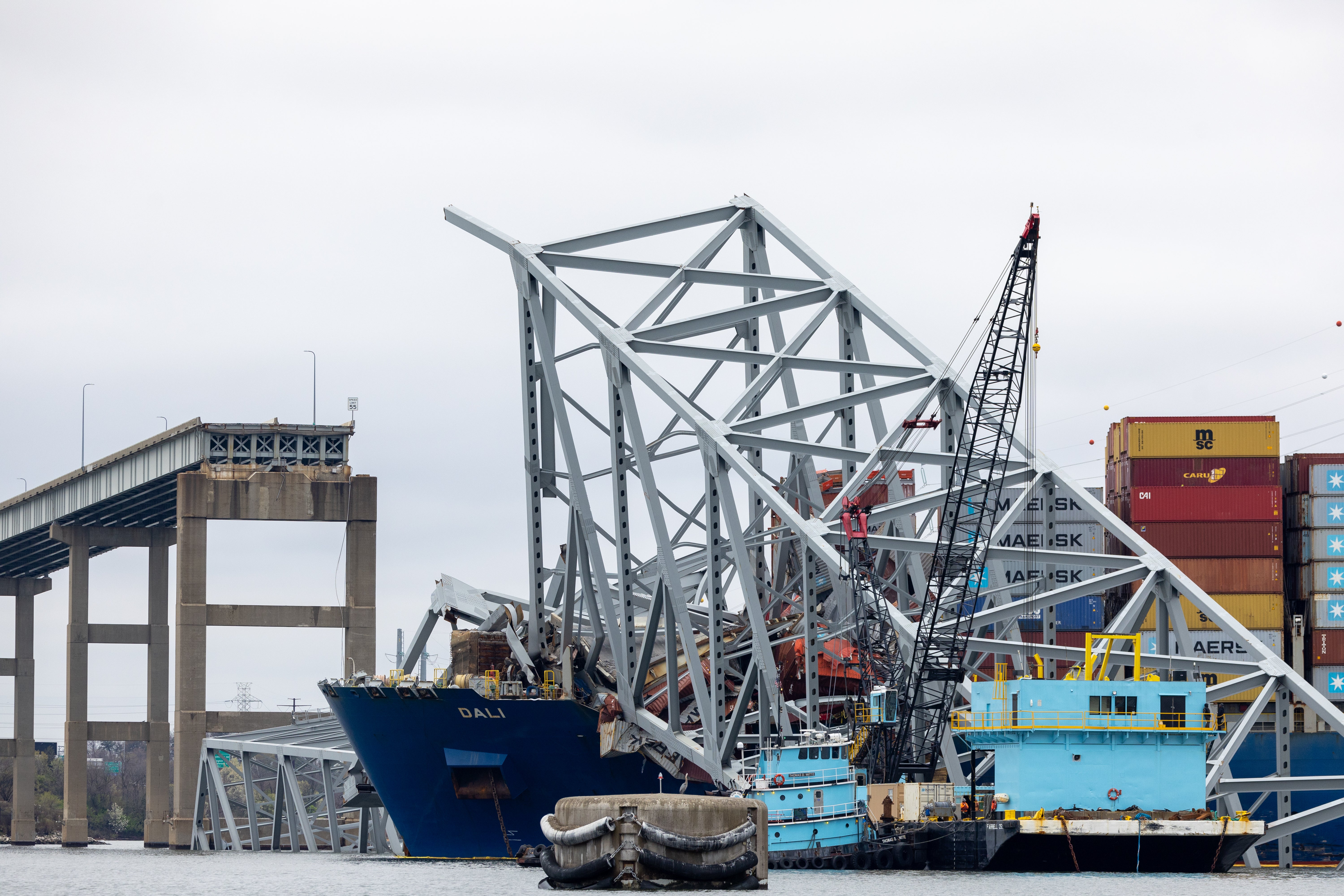
Authorities in the US said there was no immediate plan to disembark the crew members as workers raced against time to clean up the bridge’s debris from the Patapsco River.The sailors would likely stay on board until the ongoing investigation was completed.
"The crew members were busy with their normal duties on the ship and assisting the National Transportation Safety Board (NTSB) and Coast Guard investigators," a spokesperson for Grace Ocean Pte Ltd, the owner of the vessel, told news agency PTI.
"At this time, we do not know how long the investigation process will take and until that process is complete, the crew will remain on board."
The Synergy Group, which manages the vessel, said in a statement that the NTSB – an independent US government investigative agency – boarded the vessel on Wednesday and collected documents, voyage data recorder extracts, and began interviewing the sailors as part of their investigation.
The Port of Baltimore opened a temporary channel on Monday, freeing some tugs and barges that had been trapped by the bridge collapse.
One of last people to cross Baltimore bridge describes harrowing drive
A Maryland man said he considers himself “lucky” while reflecting on being one of the last drivers to go across the Francis Scott Key Bridge in Baltimore moments before it was struck by a cargo ship and sent crumbling into the Patapsco River.
Larry DeSantis was making his daily commute last Tuesday to his second job at Herman’s Bakery in the Baltimore area when he crossed the bridge shortly before 1:30 a.m. He told The Baltimore Banner he remembered slowing down to look out for highway workers doing construction on the bridge and now realizes he witnessed some of the workers’ final moments before they presumably died in the collapse.
He did not notice a ship coming toward the bridge or the black smoke coming out of it and later told CNN the only indication of something being wrong was the lack of vehicles on the roadway, even at that time of day.
“I really didn’t even see the ship at all. I just focused on what was right in front of me,” he told CNN. “There was one other vehicle behind me. It was a tractor, but he didn’t have a trailer because I actually got in front of him right as we started to go over the bridge.”
DeSantis was off the bridge by around 1:27 a.m., and at 1:29 a.m., a 984-foot cargo ship, named the Dali, crashed into bridge, causing it to collapse. Officials said the Dali was attempting to leave Baltimore Harbor on its way to Sri Lanka when it lost power.
The ship was able to issue a last-minute mayday call to allow police to stop traffic moments before the crash, but the eight individuals working on the bridge were not able to get off and fell into the water. Two of the workers were rescued and survived, and divers found two bodies in a submerged truck. The four others are presumed dead.
“I mean, they were doing their job, and they lost their lives. It’s hard; I drove right by them; I saw all of them, just a minute before they probably died,” he said.
DeSantis told The Baltimore Banner, which broke the story, he did not hear the noise from the crash because he had a radio channel playing.
“I didn’t even know anything was going on, but it was just really eerie when I got off of the bridge and there was nothing [behind me],” DeSantis said. “Because with Amazon there, I’ll see 20 Amazon trucks every morning. I don’t care what day of the week it is. Nothing. There was absolutely nothing.”
Minutes later, he received a call from a co-worker to make sure he was OK and later from a Maryland Transportation Authority Police detective.
“I think about it; I might not be here now if I had been just a little bit later,” he said. “Just a minute would’ve changed everything. It’s scary, you know.”
DeSantis said he has gone to work each day since the collapse, though his commute now takes closer to an hour than 20 minutes, like before.
“I’ve been very tired this week because of the amount of hours I’ve been working, but it makes you think a lot, it really does,” he told CNN. “I just can’t believe it happened. I consider myself very lucky.”
A lifelong resident of the Baltimore area, DeSantis said it is “hard to believe” the landmark bridge is gone and only remembers one other time in his life when the skyline did not have the bridge — when it was being built.
The bridge collapse has closed the Port of Baltimore, a major shipping hub along the East Coast that supports more than 15,000 direct jobs and more than 139,000 indirect jobs, Axios reported last week.
The U.S. Coast Guard announced Monday it is expected to open an auxiliary channel for commercially essential vessels near the site of the wreckage.
“This will mark an important first step along the road to reopening the port of Baltimore,” Coast Guard Capt. David O’Connell, the federal on-scene coordinator for the joint command response, said in a statement. “By opening this alternate route, we will support the flow of marine traffic into Baltimore.”
Crews began removing the first piece of wreckage from the water over the weekend, Maryland Gov. Wes Moore said.
Moore, along with other state and federal officials said the port’s closure will not only impact Maryland’s local economy but will also have ripple effects on a national level. No definitive timeline has been determined for when the port could reopen as the salvage and rebuilding process is expected to be extensive.
What does it mean for a ship to be S’pore-flagged, and why is S’pore involved in the probe?
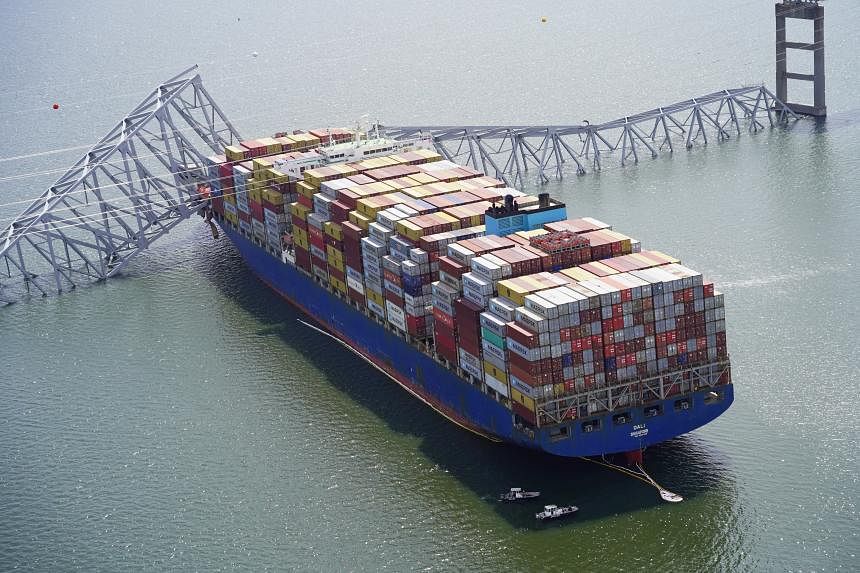
UPDATED
MAR 28, 2024
SINGAPORE - A container ship that crashed into the Francis Scott Key Bridge in Baltimore on March 26 was sailing under the Singapore flag, spawning questions about what this means, why Singapore’s authorities are involved in the investigation and the parties that could be held liable.
The Straits Times looks at what it means for a ship to be registered in Singapore and why investigators here have been sent to the United States to aid in the probe.
1. What does it mean when a ship is Singapore-flagged?
Under international maritime law, all merchant ships participating in international trade need to be registered in a country of the shipowner’s choosing, called the flag state. Each ship is bound by the laws of the flag state that it is registered in.
The Singapore Registry of Ships, which was established in 1966, is responsible for overseeing Singapore-flagged ships and ensuring that these vessels and their owners meet local and international regulations covering areas such as crew safety and environmental protection.
Singapore’s ship registry, which was the fifth-largest in the world in 2023 according to Lloyd’s List Intelligence, comes under the purview of the Maritime and Port Authority of Singapore (MPA).
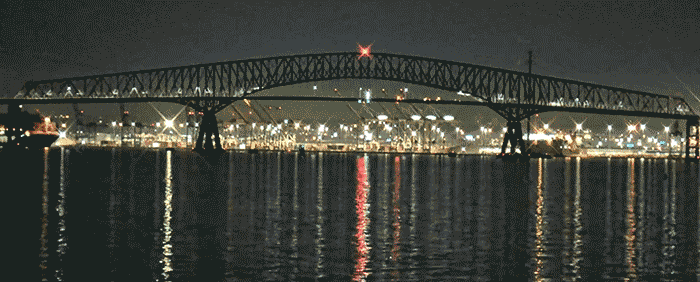
2. How many vessels fly the Singapore flag, and what is needed for a ship to get on the registry?
As at January, there were about 4,000 vessels being administered under the Singapore Registry of Ships, representing a total internal ship capacity of more than 100 million gross tons.
Except for certain vessels like fishing boats, all types of ships, including offshore vessels such as oil rigs, can be registered with the Singapore ship registry so long as they comply with the relevant international standards.
According to MPA’s website, vessels that are less than 17 years old and meet these requirements are normally accepted for registration.
MPA has said that the Singapore flag has become a flag of choice for many shipowners and operators due to the quality of the ship registry here.
Other advantages of flying the Singapore flag that have been cited within the shipping industry include the ease of incorporating a Singapore company, as well as tax exemptions and various incentive schemes.
3. Who can be registered as owners of Singapore-flagged ships?
Only Singapore citizens, permanent residents or companies incorporated in Singapore may be registered as owners of Singapore-flagged ships. These companies can be locally or foreign-owned.
For a company to be registered as the owner of a Singapore-flagged ship, it must have a minimum paid-up capital of $50,000. But this requirement may be waived depending on the number of ships being registered and their aggregated tonnage.
The owner of every Singapore ship must appoint a manager whose residence is in Singapore, according to MPA. The ship manager may be an officer of the owning company or of a management company, and he is responsible for all matters related to ship registration and crew manning, as well as safety at sea.
In the case of the Dali container ship – which rammed into one of the pillars of the Francis Scott Key Bridge in Baltimore, in the United States, resulting in six people presumed dead – the shipowner is Singapore-based firm Grace Ocean.
The ship’s appointed manager is Synergy Marine Group, a Singapore-headquartered company, which hired and manages the crew aboard the Dali.
Synergy, which manages 668 vessels, oversees various aspects of operations for shipowners, such as docking procedures and risk management.
Baltimore bridge collapse: S’pore-flagged ship passed inspections in 2 foreign ports in 2023
4. Why is MPA involved in the probe, and what are its responsibilities in terms of maritime safety?
Mr Moses Lin, partner and head of shipping at law firm Shook Lin & Bok, said MPA ensures Singapore-flagged ships have complied with relevant safety regulations.
It also ensures that these ships have undergone the regular inspections and certifications needed for a vessel’s structural integrity, seaworthiness and safety.
But flag states, he noted, do not have direct responsibility for the day-to-day operational safety of vessels.
In an accident like the Baltimore one, just because the ship involved is registered in Singapore does not mean the Republic is responsible, said Associate Professor Goh Puay Guan of the National University of Singapore Business School and Centre for Maritime Studies.
“Safety checks and compliance checks would likely have been conducted regularly, and as long as these are done in accordance with procedure, the regulatory bodies would have carried out their responsibilities,” he added.
Under international law, flag states must conduct an inquiry into any marine casualty or incident involving a ship flying its flag that causes loss of life or serious injury to nationals from another state, or causes serious damage to ships or installations of another state.
The flag state must also cooperate in any inquiries held by the other state into such incidents.
In the case of a marine casualty or incident, owners and masters of Singapore-registered ships must first take urgent steps on the ground to prevent further deterioration of the situation.
Once that is done, they should alert MPA to the incident immediately or within two hours of the incident at the latest. A more detailed report should then be submitted within 24 hours of the occurrence.
5. Why are investigators from Singapore’s Transport Safety Investigation Bureau (TSIB) being sent to Baltimore?
TSIB – a department of Singapore’s Ministry of Transport (MOT) – is the authority responsible for investigating air, marine and rail accidents and incidents here.
When it was set up in 2016, it took over the task of carrying out independent safety investigations into marine accidents from MPA.
The bureau will investigate incidents that occur in Singapore with a “very serious marine casualty”, regardless of the country the ship is registered in, or those that involve a Singapore-registered ship when it is overseas.
These “very serious” incidents involve the total loss of a ship, a death, or severe damage to the environment. TSIB may also investigate marine casualties and marine incidents where safety lessons can be drawn.
MOT has said TSIB’s investigations are aimed at preventing accidents and incidents, and not to ascribe blame or liability. Still, any investigation being conducted by the bureau does not prevent other entities, such as MPA, from conducting their own probes.
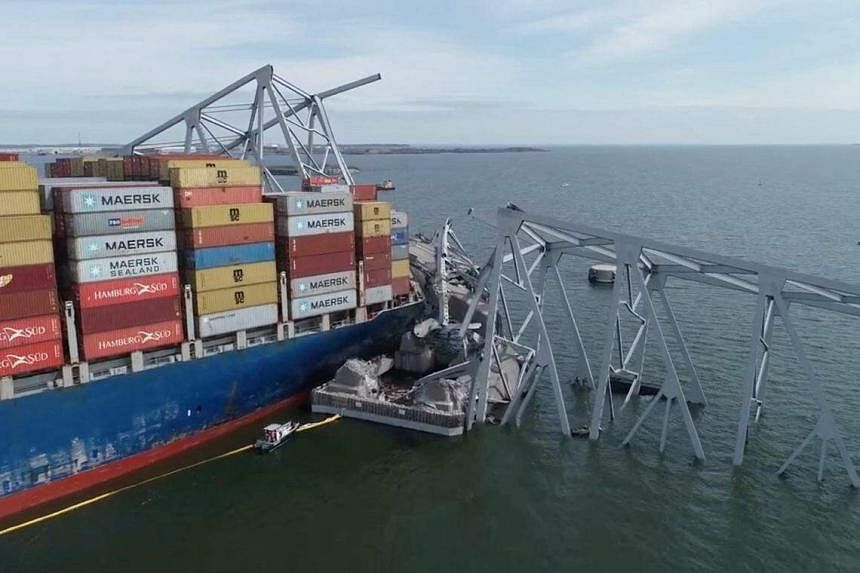
6. Which party bears the liabilities in such accidents?
As early investigations into the Baltimore bridge collapse are under way, it is difficult to ascertain which party would be liable for damages, legal experts told ST.
Major parties that might be potentially responsible include the shipowner, operator, charterer, captain or master of the vessel, said Shook Lin & Bok’s Mr Lin.
The Dali container ship was chartered by Danish shipping giant Maersk at the time.
Losses would likely include damage to the bridge, business and service disruptions, and the loss of lives, said lawyer Kevin Chan.
Depending on the outcome of the investigation, Grace Ocean can seek compensation from relevant parties, lawyers said.
“If it was an engine failure which caused the vessel to lose power and collide with the bridge, it might be the operator or the engineer who was responsible,” said Mr Mathiew Rajoo, partner at DennisMathiew law firm.
The company that hired the parties responsible may then be liable, he added.
Port pilots may also be held liable in certain situations.
“Pilots typically board ships in local waters to direct the ship as these waters could be small and narrow or have conditions that the ship’s captain may not be aware of. “So, in certain instances, it could also be the pilot’s fault for failing to direct the vessel correctly,” Mr Lin said.
Grace Ocean may shield itself from damages by filing for a limitation-of-liability action under maritime law, said Mr Mathiew. The liability will be based on the tonnage of the vessel.
But the company, he said, will not be entitled to the limitation if it is established that the loss resulted from a deliberate act or omission.
The shipowner would also likely be covered by insurance, said lawyers.
The ship has been insured by the Britannia Protection and Indemnity Club, a mutual insurance association owned by shipping companies, since 2014.

According to its website, the insurance group covers areas such as loss of life, liability to cargo and collision liability.
But there may be instances where shipowners could be denied their claims, depending on the terms of the policy, said Mr Chan.
“Possible situations where coverage may be excluded would include the vessel’s failure to maintain its class (a certification of its technical standards) required under the policy, or if the collision was intentional or a result of wilful misconduct by the shipowner,” he said.Additional reporting by Grace Leong
Biden faces pressure from foreign partners, rights groups and some fellow Democrats in Congress to impose conditions on arms transfers to Israel.
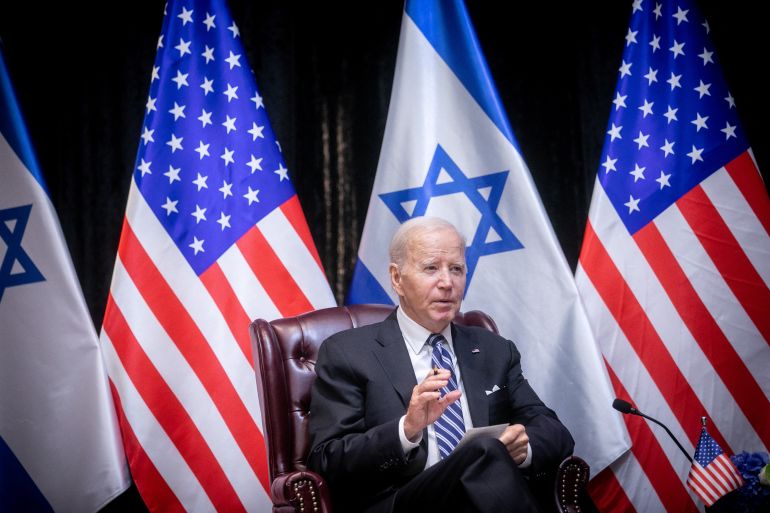
Published On 2 Apr 2024
US President Joe Biden’s administration is weighing whether to go ahead with an $18bn arms transfer package to Israel that would include dozens of F-15 aircraft, according to the Reuters news agency.
The sale of 25 F-15s has been under review since the US received the formal request in January 2023, Reuters reported, citing one of five sources familiar with the plans, long before Israel’s six-month-old military campaign in Gaza. This sale would boost that number to as many as 50 F-15s.
US doubles down on its defence of arming Israel despite Gaza atrocities
Accelerating delivery of the aircraft was among the top requests from Israeli Minister of Defense Yoav Gallant, who visited Washington last week and held talks with US officials including National Security Advisor Jake Sullivan and Secretary of Defense Lloyd Austin, a second source said.
Biden faces pressure from foreign partners, human rights groups and some of his fellow Democrats in Congress to impose conditions on arms transfers to rein in Israel’s offensive in Gaza where health officials say at least 32,845 Palestinians have been killed, many of them civilians.
One US official said that even if formal notification were sent to Congress tomorrow and the deal was finalised immediately, the earliest the aircraft would be delivered would be 2029. Israel is seeking to beef up its already formidable fleet of warplanes not just for its continuing fight against Hamas but to ward off any further threat from the Tehran-backed Lebanese armed group Hezbollah on its northern border as well as from regional rival Iran.
House of Representatives Foreign Affairs Committee Chairman Michael McCaul gave the green light for the F-15 sale on January 30, a committee aide told Reuters, when the relevant congressional offices responsible for approving major arms transfers were notified.
“Administration-Congressional deliberations on the F-15 case have already occurred,” the second source familiar with the matter said, but added that some of the four officers required to sign off on any arms transfers had yet to do so.
US law requires Congress to be notified of significant foreign military sales agreements and allows it to block such sales by passing a resolution of disapproval if there is concern about human rights violations or other issues, although no such resolution has ever passed and survived a presidential veto.
An informal review process allows the Democratic and Republican leaders of foreign affairs committees to vet such agreements before a formal notification to Congress.

The Israel package includes 50 F-15 aircraft, and support services, training, maintenance, sustainment and many years of contractor support during the jets’ lifecycle, which could typically go for up to two decades, the sources told Reuters.
One source said the Biden administration had expressed support to Israel for its F-15 request. Washington has publicly expressed concern about Israel’s proposed military offensive in Rafah, the southernmost city of the Gaza Strip where many Palestinians have taken shelter after being displaced by Israel’s assault.
Israel is also facing accusations it has violated international humanitarian law – a set of rules aimed at protecting civilians in armed conflicts, including the Geneva Conventions.
Witnesses and rights groups have accused Israel of indiscriminate bombing, targeting civilian infrastructure, mistreating detainees, extrajudicial executions and using humanitarian aid as a weapon of war, among other abuses.
But last week, the State Department said it had not found Israel to be in violation of international humanitarian law in any incident.
This sale is separate from the $14bn in aid for Israel that Biden has asked Congress to approve as part of a sweeping $95bn national security supplemental spending package that also includes aid for Ukraine and Taiwan.
Washington gives $3.8bn in annual military assistance to Israel, and the administration has so far resisted calls to condition any arms transfers even though senior US officials have criticised Israel over the high civilian death toll.
On Sunday, Democratic Senator Jeff Merkley invoked the Easter holiday to condemn the war on Gaza.
“We must also recognise that America is complicit in this tragedy by resupplying Israel with bombs and failing to use America’s leverage to increase aid delivered into Gaza,” he wrote in a series of social media posts.
SOURCE: AL JAZEERA, REUTERS
By Adam Taylor
April 2, 2024
Israel has received more U.S. military aid — and more U.S. aid of any type — than any other country since World War II.
That assistance has long been a matter of ironclad, bipartisan near-consensus. But in recent months, it has come under mounting scrutiny, including from some Democratic legislators, amid the emergence of rifts between the United States and Israel over Israel’s conduct in its war in Gaza — in which U.S.-provided weapons are in widespread use.
Israel has been waging war in Gaza since Oct. 7, when Hamas, the Palestinian group that has long controlled the territory, led a cross-border attack that left 1,200 people dead. The Israeli assault on Gaza has left the Strip in ruins, and has left at least 32,000 Gazans dead, according to the Gaza Health Ministry, which does not distinguish between combatants and noncombatants.
The United States has supplied Israel with weapons since the war began. While President Biden has pushed for Israel to allow more aid into the enclave to avert famine and has resisted Israeli plans to invade the southern Gaza city of Rafah, where displaced Palestinians are densely packed, military aid has remained untouched.
Here is what to know about U.S. military aid to Israel.
What weapons has the U.S. provided to Israel since Oct. 7?
Since Oct. 7, the Biden administration has made public two major military sales to Israel.
In December, the administration approved the sale of nearly 14,000 tank ammunition cartridges and equipment to Israel, worth $106.5 million, and the sale of 155mm artillery shells and related equipment worth $147.5 million. The White House bypassed congressional approval for both sales by invoking emergency authority.
These transfers represent only a small portion of total aid. U.S. officials have briefed Congress on more than 100 other transactions that fell under a set dollar amount required for notification. Among the weapons sold were precision-guided munitions, small-diameter bombs, bunker-buster rockets and other lethal aid, people with knowledge of the briefings told The Washington Post in March.
U.S.-made weapons have been used widely in Gaza since Oct. 7, though it is not clear when they were purchased or delivered. Independent analysts have said that many of the weapons used in Gaza appear to be 1,000- or 2,000-pound bombs such as the Mark 84, which can be retrofitted with Boeing-manufactured JDAM (Joint Direct Attack Munition) kits to become precision weapons.
In March, the Biden administration authorized the transfer of 1,800 MK84 2,000-pound bombs and 500 MK82 500-pound bombs. The transfers had been approved by Congress several years ago but had not been fulfilled. The State Department has also authorized the transfer of 25 F-35A fighter jets and engines, U.S. officials told The Post last week.
The United States has maintained a stockpile of weapons in Israel, known as the War Reserve Stocks for Allies-Israel, since the 1990s. The U.S. military pulled 155mm shells out of the stockpile to send to U.S. reserves in Europe after the 2022 Russian invasion of Ukraine.
Defense officials told reporters in late October, following the Oct. 7 Hamas attack, that many of the stockpiled shells had been redirected: to the Israel Defense Forces.
What is the history of U.S. military aid to Israel?
During the 1970s, Washington provided significant surges in military aid to Israel as the country rebuilt its forces after the 1973 Yom Kippur War, in which a coalition of Arab nations, led by Egypt and Syria, launched an attack on Israel.
Since then, military aid has remained largely steady if adjusted for inflation, with the stated aim of helping Israel maintain a “qualitative military edge” over its neighbors.
In recent years, funding has been outlined in 10-year memorandums of understanding. In the most recent memorandum, signed in 2016, Washington pledged $38 billion in military assistance between the 2019 and 2028 fiscal years.
Most U.S. military aid to Israel falls under the Foreign Military Financing program, which provides grants that Israel uses to purchase U.S. military goods and services. The United States also contributes about $500 million annually for joint missile defense systems. Since 2009, the United States has contributed $3.4 billion to missile defense funding, including $1.3 billion for the Iron Dome, which stops short-range rockets, the State Department said last year.
Israel has been granted access to some of the most coveted U.S. military technology. It was the first international operator of the F-35 fighter jet and used the craft in combat for the first time in 2018.
U.S. support, and industrial cooperation between U.S. and Israeli defense companies, has helped Israel build up its defense industry: The country is one of the world’s top arms exporters.
After the Oct. 7 attacks, the Biden administration requested a further $14 billion in military aid to Israel, to include money for missile defense. The funding request passed the Senate but has stalled in the House.
Why is U.S. military aid to Israel under increased debate?Return to menu
The high impact of Israel’s Gaza offensive on civilians has led to renewed debate about U.S. military aid. Biden has called Israel’s bombing campaign “indiscriminate.”
U.S. laws govern the transfer of military equipment to foreign governments. Among them, the Leahy Law prohibits transferring military aid to foreign governments or groups that commit gross human rights violations. On Feb. 8, Biden issued a national security memorandum detailing these rules and adding a new requirement that the administration submit an annual report to Congress about whether recipients are meeting the standards.
To make that assessment, the State Department requested written assurances from countries receiving U.S. weapons that they are abiding by existing U.S. standards, including requirements related to the protection of civilians. The U.S. memorandum says recipient countries must “facilitate and not arbitrarily deny, restrict, or otherwise impede, directly or indirectly, the transport or delivery of United States humanitarian assistance” or U.S.-supported international efforts to provide aid.
The State Department received Israel’s written assurances ahead of a March 24 deadline. It now has until early May to formally assess whether these assurances are credible and to report to Congress. State Department spokesman Matt Miller said on March 25 that there were no indications of legal violations.
Humanitarian groups have called on the Biden administration to not accept Israel’s assurances at face value. They say Israel, despite its insistence otherwise, is impeding the flow of aid into Gaza by truck, through long inspections at checkpoints and by refusing to open new ones. “Given ongoing hostilities in Gaza, the Israeli government’s assurances to the Biden administration that it is meeting U.S. legal requirements are not credible,” Sarah Yager, Washington director at Human Rights Watch, said in a statement.
In a letter to the Biden administration released on March 22, 17 Democratic senators said that acceptance of assurances from the Netanyahu government would be “inconsistent with the letter and spirit” of Biden’s national security memorandum, and would set an “unacceptable precedent” for “other situations around the world.
US base in Syria comes under drone attack

TEHRAN, Apr. 02 (MNA) – The illegal base of the United States in eastern Syria came
The US base in Syria's al-Tanf region was targeted with a suicide drone, local sources reported on Tuesday morning.
No group has claimed responsibility for targeting the US base so far.
Resistance groups based in Iraq have repeatedly hit US bases on Iraqi and Syrian territories with missiles and drones over the past weeks in retaliation for the Israeli regime’s crimes against Palestinians in Gaza.
The groups are also outraged at the US military presence in the region, which they see as a source of instability, as well as Washington’s support for the Israeli regime in its ongoing war on Gaza.
MP/TSN channel


